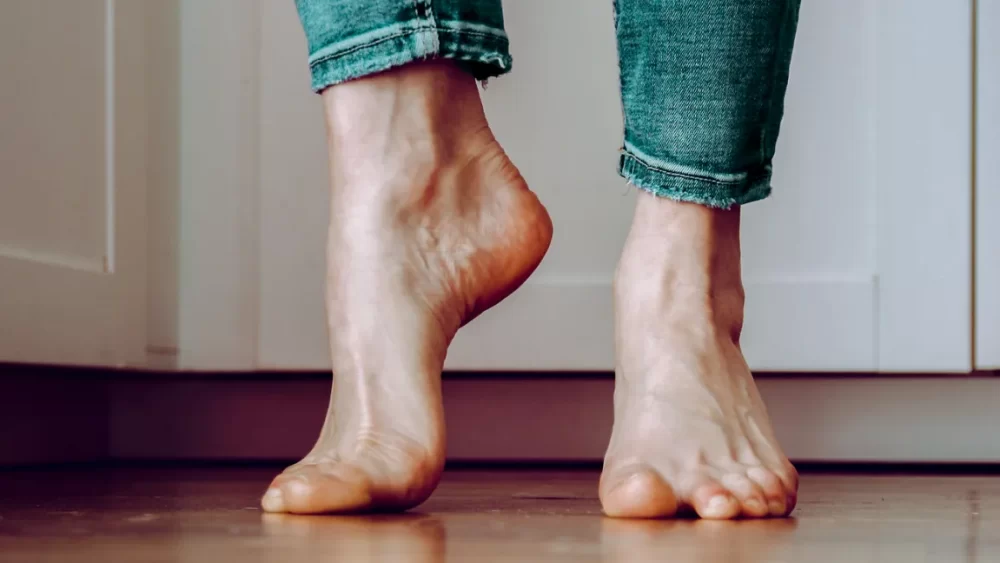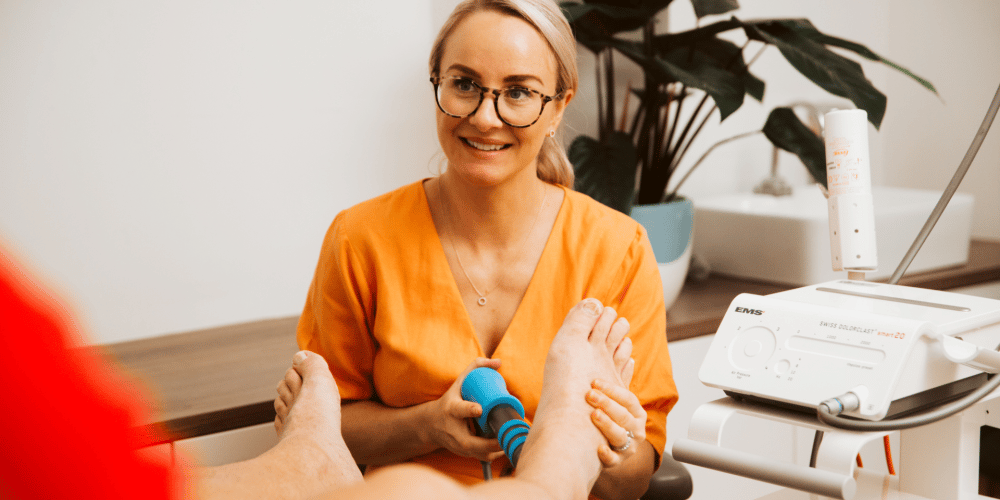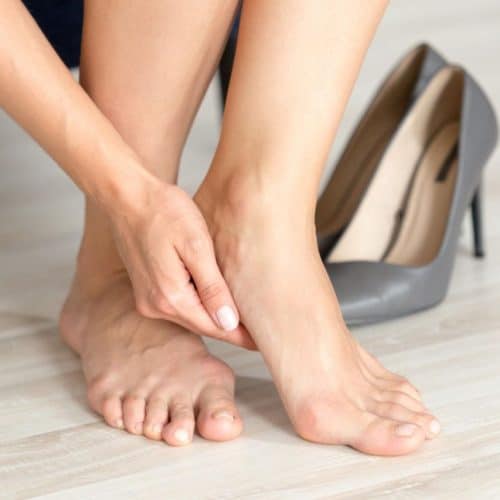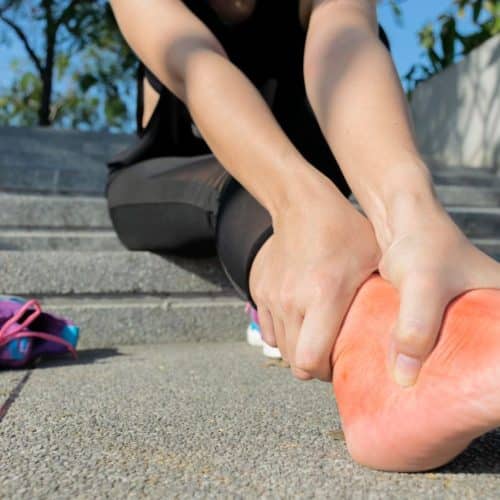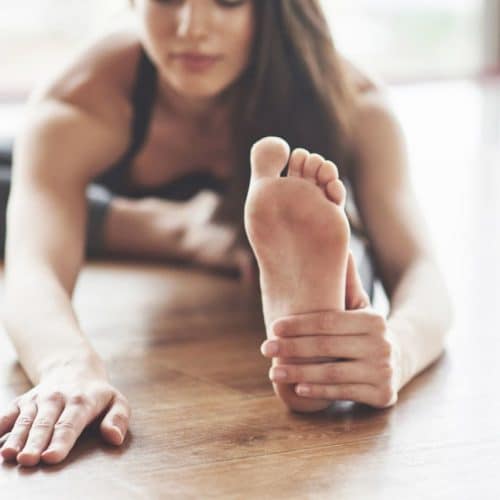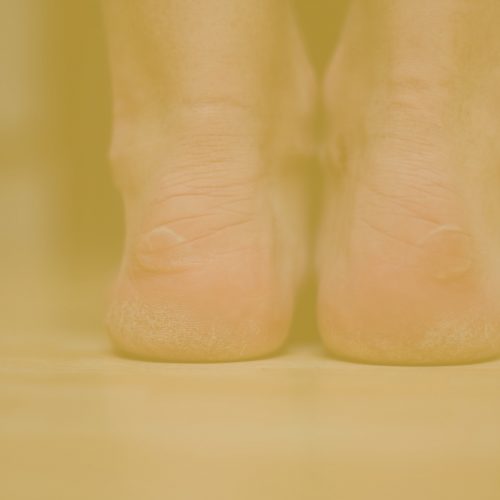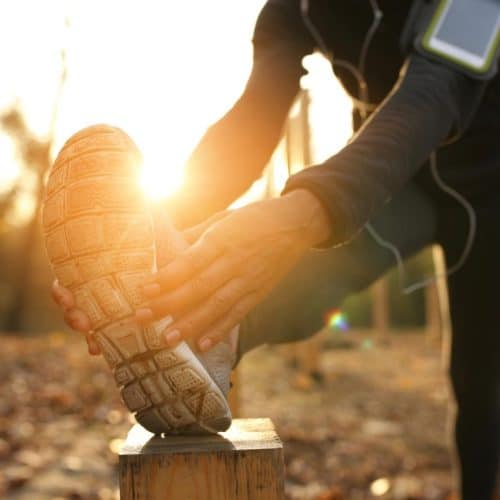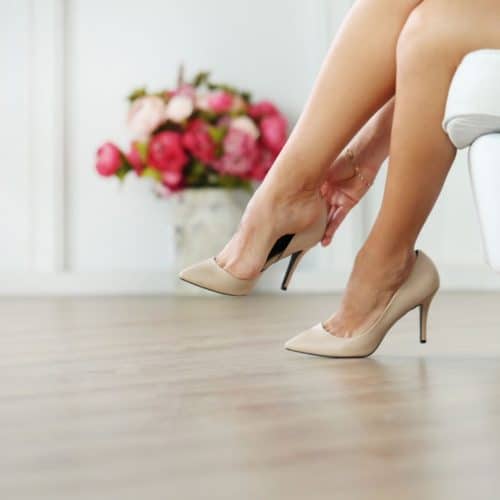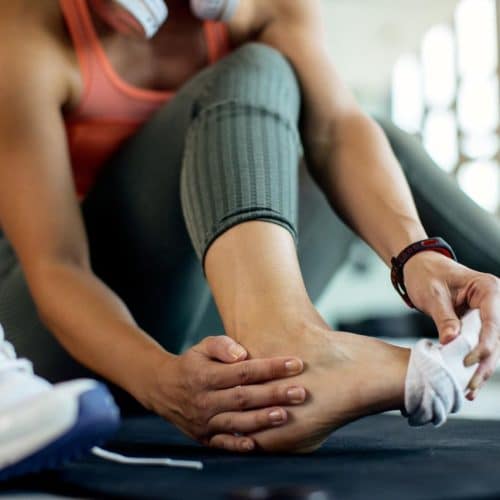Do you wake up every morning with aching heels? Does that first step feel like you’re treading on glass? If so, you might be dealing with the notorious discomfort of plantar fasciitis. The good news is that relief might be just a massage away. But can you address this nagging pain on your own? Let’s uncover the self-massage techniques that could set your feet on the path to recovery.
Understanding Plantar Fasciitis
Before delving into the effective self-massage techniques for alleviating the discomfort of plantar fasciitis, it’s important to gain a comprehensive understanding of this condition and the factors that contribute to its onset.
1. What is Plantar Fasciitis?
Plantar fasciitis is a common foot ailment that may be quite painful and is characterised by excruciating pain in the heel. This ailment predominantly affects the plantar fascia, which is a strong and fibrous tissue band that spans the bottom of the foot from the heel bone (calcaneus) to the base of the toes.
It is also known as runner’s heel and foot arch pain. The plantar fascia is an important structure that helps keep the foot arch in place and absorbs stress when the foot is in motion, such as during walking or running.
2. Common Causes
In most situations, plantar fasciitis develops as a consequence of a confluence of events that place an unusually high level of stress on the plantar fascia. This stress might come from running, jumping, or simply standing on hard surfaces for long periods of time. Some of the most common contributors to the development of plantar fasciitis include:
- Repetitive Strain: Engaging in activities that involve repetitive movements, such as prolonged walking, running, or standing, can overexert the plantar fascia. This consistent strain can eventually lead to inflammation and micro-tears within the tissue.
- Improper Footwear: Wearing footwear that lacks adequate arch support, cushioning, or proper fit can exacerbate the risk of plantar fasciitis. Ill-fitting shoes can disrupt the foot’s natural alignment and cause the plantar fascia to endure additional stress.
- High Arches or Flat Feet: Individuals with high arches or flat feet are more prone to developing plantar fasciitis. High arches place excessive tension on the plantar fascia, while flat feet lead to an altered distribution of body weight, causing the tissue to bear disproportionate pressure.
- Tight Calf Muscles: Plantar fasciitis can be indirectly caused by tight calf muscles, making the condition much more painful. When the calf muscles are tight, they reduce the flexibility of the Achilles tendon, which in turn affects the strain that the plantar fascia feels.
Plantar fasciitis arises from a combination of mechanical and lifestyle factors that place undue strain on the plantar fascia. This strain leads to inflammation, pain, and the characteristic discomfort associated with the condition. Recognising the underlying causes of plantar fasciitis is important to address them and prevent their recurrence effectively.
Understanding the intricacies of plantar fasciitis is essential for anyone seeking to manage and alleviate its symptoms. By comprehending the role of the plantar fascia and recognising the factors contributing to its inflammation, individuals can adopt proactive measures to mitigate the discomfort associated with it.
The Benefits of Self-Massage
Self-massage can be a powerful and accessible tool in your arsenal for managing the discomfort associated with plantar fasciitis. While it’s not a replacement for professional medical advice, diagnosis, or treatment, incorporating self-massage into your routine can offer several valuable benefits:
1. Enhanced Blood Circulation
One of the primary benefits of self-massage is the improvement of blood circulation in the affected area. The targeted pressure and movement stimulate blood flow to the plantar fascia and the surrounding tissues. This increased circulation brings essential nutrients and oxygen to the area, aiding healing. Additionally, improved circulation helps flush toxins and reduce inflammation, which are key factors in managing plantar fasciitis.
2. Muscle Relaxation
Tense muscles often accompany plantar fasciitis, contributing to pain and discomfort. Self-massage techniques, such as rolling a tennis ball under your foot, can effectively release muscle tension. As you apply pressure and manipulate the tissues, muscle fibres relax, reducing tightness and promoting a sense of relief. Relaxed muscles can also assist in maintaining proper alignment and reducing strain on the plantar fascia.
3. Breakdown of Adhesions
Over time, the plantar fascia can develop adhesions—bands of rigid tissue that limit its flexibility. Self-massage techniques help break down these adhesions, restoring a greater range of motion to the fascia. By working on these adhesions, you can potentially reduce the feeling of stiffness and improve the overall function of the foot.
4. Pain Reduction
The hallmark of plantar fasciitis is the sharp, stabbing pain that often accompanies the first steps in the morning or after periods of inactivity. Self-massage can directly address this pain by targeting the inflamed area. Gentle yet purposeful pressure applied during self-massage stimulates nerve endings and triggers the release of endorphins—natural pain-relieving chemicals. This can lead to temporary pain reduction and provide welcome relief.
5. Psychological Benefits
Chronic pain can take a toll on your mental well-being. Incorporating self-massage into your daily routine can have positive psychological effects. Taking time for self-care, focusing on your body’s sensations, and practising mindfulness during the massage can reduce stress and improve your overall outlook.
6. Empowerment and Active Participation
Dealing with plantar fasciitis can often make you feel at the mercy of your symptoms. Self-massage empowers you by allowing you to take an active role in managing your condition. It’s a proactive step that enables you to address your discomfort on your terms, enhancing your sense of control over your health.
7. Complementary to Other Treatments
Self-massage is not meant to replace medical treatments or interventions recommended by healthcare practitioners. However, it can serve as a valuable complementary approach. Self-massage can contribute to a more holistic and comprehensive plantar fasciitis management plan when used alongside treatments such as physical therapy, stretching exercises, and orthotic inserts.
Self-Massage Techniques
Self-massage techniques can serve as invaluable tools in your wellness arsenal for finding relief from the persistent discomfort of plantar fasciitis. These techniques, when executed correctly and consistently, can aid in reducing pain, improving blood circulation, and promoting overall relaxation. Here are some self-massage techniques that you can integrate into your daily routine to effectively manage plantar fasciitis:
1. Frozen Water Bottle Roll
The frozen water bottle roll technique combines the benefits of massage with the soothing effects of cold therapy. To perform this technique, freeze and place a water bottle on the floor. Gently roll your foot back and forth over the bottle, applying controlled pressure to the plantar fascia. The cold temperature helps reduce inflammation, while the rolling motion massages the tissue. Aim for 15-20 minutes of rolling daily. This is most beneficial for initial plantar fascia trauma and pain, however heat is the preferred method for any chronic or long standing plantar fascia pain.
2. Tennis Ball Massage
A tennis ball can be an effective tool for targeting specific trigger points in the foot. Sit on a chair and place the tennis ball beneath your foot. Apply gentle pressure and roll the ball back and forth. As you identify areas of tension or discomfort, pause and allow the ball to provide a targeted massage. This technique helps release knots and adhesions in the plantar fascia, promoting relaxation.
3. Arch Roll
The arch roll technique focuses on stretching and massaging the arch of the foot. Use a golf ball or a specialised foot roller for this technique. Place the ball or roller beneath the arch of your foot and roll it from the heel to the ball of your foot. Apply moderate pressure and repeat the rolling motion several times. This technique can alleviate tightness in the arch and enhance flexibility.
4. Toe Stretch
After performing some light toe stretching, you may notice that the plantar fascia and the muscles in the surrounding area feel better. Take a place that is comfortable for you, and while you are seated, use one hand to bring your toes up towards your shin in a slow and gentle motion.
When you have held the stretch for fifteen to twenty seconds, you should then release it. You may improve your flexibility and reduce any stress you may be feeling by performing this stretch several times on each foot.
5. Foot Flex
The foot flex technique is a simple yet effective way to relieve tension in the plantar fascia. Sit down and cross one leg over the opposite knee. Hold your toes with your hand and gently flex them upward. You should feel a stretch along the bottom of your foot. Hold the stretch for a few seconds, and then release. Repeat on both feet.
Incorporating these self-massage techniques into your daily routine can offer significant relief from the discomfort of plantar fasciitis. Remember to start gently and gradually increase pressure as your body becomes accustomed to the massage.
While self-massage can provide relief, consulting with a healthcare practitioner for a comprehensive treatment plan is important, especially if your condition is severe or persistent.
Incorporating Massages into Your Routine
Effectively managing plantar fasciitis requires a consistent and holistic approach. Alongside proper footwear, lifestyle adjustments, and professional guidance, incorporating self-massage techniques into your daily routine can be a powerful tool in alleviating the discomfort associated with this condition. Here’s how you can seamlessly integrate these self-massage techniques into your routine for optimal results:
1. Morning Ritual
Start your day with a rejuvenating self-massage routine. Before you step out of bed, take a moment to massage your feet using the techniques mentioned earlier. This helps warm your foot muscles, improve blood circulation, and prepare your feet for the day ahead.
2. After Activity
Activities such as running, walking, or standing for extended periods can exacerbate the symptoms of plantar fasciitis. After engaging in these activities, perform a post-activity massage for a few minutes. This helps alleviate any tension that may have built up in the plantar fascia and relieves discomfort.
3. Before Bed
Incorporating a self-massage routine before bedtime can be incredibly relaxing. Gently massage your feet using the techniques mentioned earlier as you wind down for the night. This helps release tension and promotes relaxation, potentially leading to better sleep quality.
4. During Breaks
If you have a sedentary job that involves prolonged periods of sitting, take advantage of your breaks to perform quick foot massages. Even a few minutes of self-massage can provide relief and prevent the onset of discomfort.
5. Listen to Your Body
Pay attention to how your feet feel throughout the day. If you notice any signs of tension, soreness, or discomfort, take a moment to perform a brief self-massage. This proactive approach can prevent the escalation of discomfort and help you maintain better foot health.
6. Combine Techniques
Don’t hesitate to combine different self-massage techniques to address various aspects of foot discomfort. For instance, you can start with the frozen water bottle roll to reduce inflammation, followed by the tennis ball massage to target specific trigger points.
Incorporating these self-massage techniques into your routine provides targeted relief and empowers you to take an active role in managing your plantar fasciitis. Remember that consistency is key; even a few minutes of self-massage each day can make a noticeable difference over time.
However, if you experience persistent or severe pain, it’s essential to consult a healthcare practitioner for a comprehensive evaluation and guidance tailored to your specific condition.
Tips and Precautions
1. Consistency is Key
Consistency plays a pivotal role in self-massage effectiveness for plantar fasciitis relief. Like any therapeutic practice, regularity is essential. Incorporate these self-massage techniques into your daily routine to experience the best outcomes. Dedicate a specific time each day to perform the massages, such as in the morning or before bedtime. Consistency helps in gradually alleviating pain, improving circulation, and enhancing the overall health of the fascia.
2. Avoid Overexertion
While self-massage intends to provide relief, it’s important to avoid overexertion. Applying excessive pressure can lead to additional discomfort and even worsen the condition. Always start with gentle pressure and gradually increase it as your body adapts. Listen to your body’s signals; if you feel pain or increased discomfort during the massage, reduce the pressure or stop the technique altogether.
3. Choose the Right Time
Selecting the right time for self-massage can influence its effectiveness. For instance, these techniques can be beneficial after a warm shower or bath. Warm water helps relax muscles and makes them more receptive to massage. Avoid immediately after intense physical activities, as your feet might be more sensitive at such times. Instead, opt for a time when you can truly focus on the massage and relax.
4. Mindful Breathing
Incorporate mindful breathing into your self-massage routine. Slow, deep breaths can help relax your body and enhance the effectiveness of the massage. As you massage different areas of your foot, inhale deeply through your nose and exhale slowly through your mouth. This technique relaxes your muscles and contributes to a calming overall experience.
5. Supportive Footwear
The type of footwear you wear during the day can impact the success of your self-massage efforts. Opt for supportive shoes with proper arch and heel support. Avoid shoes that offer minimal cushioning, as they can exacerbate the discomfort caused by plantar fasciitis. Additionally, when performing self-massage, consider doing it on a soft surface like a yoga mat or carpet to cushion your foot.
6. Gradual Progression
As you continue your self-massage journey, remember that progress takes time. You might not experience significant relief immediately. Be patient and allow your body time to respond to the techniques. Keep track of your progress and any changes in your symptoms. If you notice positive changes, continue with the techniques; if not, consult a healthcare practitioner for further guidance.
7. Holistic Approach
Remember that self-massage is just one component of managing plantar fasciitis. Incorporate other practices into your routine, such as stretching exercises, wearing orthotic inserts, and maintaining a healthy weight. A holistic approach can yield more comprehensive and lasting results in managing plantar fasciitis symptoms.
Conclusion
When relieving the pain caused by plantar fasciitis, including self-massage techniques in your daily routine might be a game-changer in pain management. When you take issues into your own hands, you save time and money and acquire the capacity to deal with the problem as soon as it emerges, which is a significant advantage.
The straightforward massage techniques that are still highly effective will be covered in this post on the blog. They are going to be helpful in easing tension, lowering inflammation, and accelerating the healing process.
Remember, consistency is key. Regularly engaging in these DIY massages can lead to gradual improvements over time. However, remaining patient and attentive to your body’s responses is important. If the pain persists or worsens, don’t hesitate to consult a healthcare practitioner for a thorough assessment and personalised advice.
Now that you know these beneficial self-massage techniques, which one are you most excited to try out first? Is there a specific massage that resonates with your needs and preferences? Share your thoughts and plans in the comments below – let’s embark on this journey to alleviate plantar fasciitis discomfort together!
Content Summary
- Plantar fasciitis, that stubborn condition causing stabbing pains in the soles of your feet, can hinder daily life.
- Fear not, as we delve into the most effective self-massage methods to alleviate the ache.
- No need to schedule expensive spa appointments – with a few minutes each day, you can find comfort in the palm of your own hands.
- Before delving into the effective self-massage techniques for alleviating the discomfort of plantar fasciitis, it’s important to gain a comprehensive understanding of this condition and the factors that contribute to its onset.
- Plantar fasciitis is a common foot ailment that may be quite painful and is characterised by excruciating pain in the heel.
- In most cases, plantar fasciitis develops as a result of a confluence of circumstances that collectively subject the plantar fascia to an abnormally high level of stress.
- Individuals with high arches or flat feet are more prone to developing plantar fasciitis.
- Plantar fasciitis can be indirectly caused by tight calf muscles, which can make the condition much more painful.
- This strain leads to inflammation, pain, and the characteristic discomfort associated with the condition.
- Recognising the underlying causes of plantar fasciitis is important to address them and prevent their recurrence effectively.
- Understanding the intricacies of plantar fasciitis is essential for anyone seeking to manage and alleviate its symptoms.
- By comprehending the role of the plantar fascia and recognising the factors contributing to its inflammation, individuals can adopt proactive measures to mitigate the discomfort associated with it.
- Self-massage can be a powerful and accessible tool in your arsenal for managing the discomfort associated with plantar fasciitis.
- One of the primary benefits of self-massage is the improvement of blood circulation in the affected area.
- Self-massage techniques, such as rolling a tennis ball under your foot, can effectively release muscle tension.
- Over time, the plantar fascia can develop adhesions—bands of rigid tissue that limit its flexibility.
- Self-massage techniques help break down these adhesions, restoring a greater range of motion to the fascia.
- By working on these adhesions, you can reduce the feeling of stiffness and improve the overall function of the foot.
- Self-massage can directly address this pain by targeting the inflamed area.
- Incorporating self-massage into your daily routine can have positive psychological effects.
- Taking time for self-care, focusing on your body’s sensations, and practising mindfulness during the massage can reduce stress and improve your overall outlook.
- Dealing with plantar fasciitis can often make you feel at the mercy of your symptoms.
- Self-massage empowers you by allowing you to take an active role in managing your condition.
- Self-massage is not meant to replace medical treatments or interventions recommended by healthcare practitioners.
- However, it can serve as a valuable complementary approach.
- Self-massage techniques can serve as invaluable tools in your wellness arsenal for finding relief from the persistent discomfort of plantar fasciitis.
- These techniques, when executed correctly and consistently, can aid in reducing pain, improving blood circulation, and promoting overall relaxation.
- A tennis ball can be an effective tool for targeting specific trigger points in the foot.
- Sit on a chair and place the tennis ball beneath your foot.
- The arch roll technique focuses on stretching and massaging the arch of the foot.
- Use a golf ball or a specialised foot roller for this technique.
- Gently stretching the toes can provide relief to the plantar fascia and surrounding muscles.
- The foot flex technique is a simple yet effective way to relieve tension in the plantar fascia.
- Incorporating these self-massage techniques into your daily routine can offer significant relief from the discomfort of plantar fasciitis.
- While self-massage can provide relief, it’s important to consult with a healthcare practitioner for a comprehensive treatment plan, especially if your condition is severe or persistent.
- Start your day with a rejuvenating self-massage routine.
- Before you step out of bed, take a moment to massage your feet using the techniques mentioned earlier.
- After engaging in these activities, perform a post-activity massage for a few minutes.
- Incorporating a self-massage routine before bedtime can be incredibly relaxing.
- Gently massage your feet using the techniques mentioned earlier as you wind down for the night.
- If you have a sedentary job that involves prolonged periods of sitting, take advantage of your breaks to perform quick foot massages.
- Pay attention to how your feet feel throughout the day.
- Don’t hesitate to combine different self-massage techniques to address various aspects of foot discomfort.
- Incorporating these self-massage techniques into your routine provides targeted relief and empowers you to take an active role in managing your plantar fasciitis.
- However, if you experience persistent or severe pain, it’s essential to consult a healthcare practitioner for a comprehensive evaluation and guidance tailored to your specific condition.
- Always start with gentle pressure and gradually increase it as your body adapts.
- Listen to your body’s signals; if you feel pain or increased discomfort during the massage, reduce the pressure or stop the technique altogether.
- Selecting the right time for self-massage can influence its effectiveness.
- Instead, opt for a time when you can truly focus on the massage and relax.
- Incorporate mindful breathing into your self-massage routine.
- Opt for supportive shoes with proper arch and heel support.
- Additionally, when performing self-massage, consider doing it on a soft surface like a yoga mat or carpet to cushion your foot.
- Be patient and allow your body time to respond to the techniques.
- Keep track of your progress and any changes in your symptoms.
- Incorporating self-massage techniques into your routine can be a game-changer in managing the discomfort caused by plantar fasciitis.
- The straightforward massage techniques that are still highly effective will be covered in this post on the blog. They will be really helpful in easing tension, lowering inflammation, and accelerating the healing process.
- Remember, consistency is key.
- Regularly engaging in these DIY massages can lead to gradual improvements over time.
FAQs About Plantar Fasciitis and Self-Massage
1. Can I do these massages if I have severe plantar fasciitis?
It’s best to consult a healthcare practitioner before attempting self-massage, especially if your condition is severe.
2. How often should I perform these massages?
Aim for daily massages, particularly in the morning and after strenuous activities.
3. Can self-massage completely cure plantar fasciitis?
While self-massage can provide relief, severe cases might require a combination of treatments.
4. Are there any risks associated with self-massage?
When done correctly, self-massage is generally safe. However, avoid excessive pressure that could cause more harm.
5. Should I stop other treatments if I start self-massage?
No, self-massage can complement other treatments. Consult your healthcare practitioner for a comprehensive plan.


